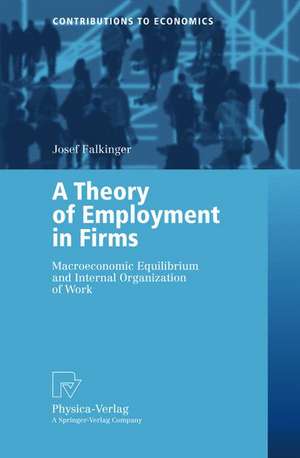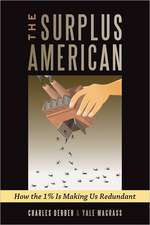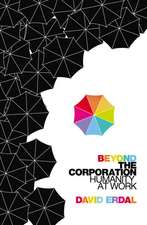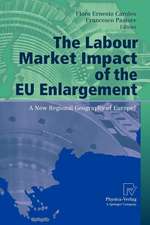A Theory of Employment in Firms: Macroeconomic Equilibrium and Internal Organization of Work: Contributions to Economics
Autor Josef Falkingeren Limba Engleză Paperback – 11 sep 2002
Din seria Contributions to Economics
- 18%
 Preț: 1001.81 lei
Preț: 1001.81 lei -
 Preț: 90.83 lei
Preț: 90.83 lei - 15%
 Preț: 649.06 lei
Preț: 649.06 lei - 18%
 Preț: 1109.92 lei
Preț: 1109.92 lei - 24%
 Preț: 657.06 lei
Preț: 657.06 lei - 18%
 Preț: 976.54 lei
Preț: 976.54 lei - 17%
 Preț: 361.01 lei
Preț: 361.01 lei - 18%
 Preț: 1027.83 lei
Preț: 1027.83 lei -
 Preț: 283.93 lei
Preț: 283.93 lei - 15%
 Preț: 644.95 lei
Preț: 644.95 lei - 15%
 Preț: 638.24 lei
Preț: 638.24 lei -
 Preț: 394.29 lei
Preț: 394.29 lei - 15%
 Preț: 636.80 lei
Preț: 636.80 lei - 15%
 Preț: 637.78 lei
Preț: 637.78 lei - 18%
 Preț: 723.69 lei
Preț: 723.69 lei - 15%
 Preț: 635.47 lei
Preț: 635.47 lei - 15%
 Preț: 634.00 lei
Preț: 634.00 lei -
 Preț: 392.75 lei
Preț: 392.75 lei -
 Preț: 383.33 lei
Preț: 383.33 lei - 15%
 Preț: 637.28 lei
Preț: 637.28 lei - 15%
 Preț: 636.80 lei
Preț: 636.80 lei - 18%
 Preț: 950.96 lei
Preț: 950.96 lei - 15%
 Preț: 634.68 lei
Preț: 634.68 lei -
 Preț: 387.38 lei
Preț: 387.38 lei - 15%
 Preț: 647.27 lei
Preț: 647.27 lei - 15%
 Preț: 636.63 lei
Preț: 636.63 lei - 15%
 Preț: 639.73 lei
Preț: 639.73 lei -
 Preț: 385.62 lei
Preț: 385.62 lei - 15%
 Preț: 641.85 lei
Preț: 641.85 lei - 20%
 Preț: 649.60 lei
Preț: 649.60 lei - 15%
 Preț: 641.71 lei
Preț: 641.71 lei -
 Preț: 387.96 lei
Preț: 387.96 lei - 15%
 Preț: 645.47 lei
Preț: 645.47 lei -
 Preț: 385.08 lei
Preț: 385.08 lei - 15%
 Preț: 646.62 lei
Preț: 646.62 lei -
 Preț: 383.33 lei
Preț: 383.33 lei - 15%
 Preț: 638.43 lei
Preț: 638.43 lei -
 Preț: 381.21 lei
Preț: 381.21 lei - 15%
 Preț: 642.51 lei
Preț: 642.51 lei - 15%
 Preț: 637.78 lei
Preț: 637.78 lei - 15%
 Preț: 641.71 lei
Preț: 641.71 lei -
 Preț: 379.86 lei
Preț: 379.86 lei -
 Preț: 378.34 lei
Preț: 378.34 lei -
 Preț: 384.70 lei
Preț: 384.70 lei -
 Preț: 388.52 lei
Preț: 388.52 lei - 15%
 Preț: 641.71 lei
Preț: 641.71 lei -
 Preț: 381.00 lei
Preț: 381.00 lei - 15%
 Preț: 644.95 lei
Preț: 644.95 lei -
 Preț: 386.00 lei
Preț: 386.00 lei
Preț: 384.70 lei
Nou
Puncte Express: 577
Preț estimativ în valută:
73.61€ • 77.06$ • 60.91£
73.61€ • 77.06$ • 60.91£
Carte tipărită la comandă
Livrare economică 07-21 aprilie
Preluare comenzi: 021 569.72.76
Specificații
ISBN-13: 9783790815207
ISBN-10: 3790815209
Pagini: 220
Ilustrații: X, 206 p.
Dimensiuni: 155 x 235 x 12 mm
Greutate: 0.34 kg
Ediția:2002
Editura: Physica-Verlag HD
Colecția Physica
Seria Contributions to Economics
Locul publicării:Heidelberg, Germany
ISBN-10: 3790815209
Pagini: 220
Ilustrații: X, 206 p.
Dimensiuni: 155 x 235 x 12 mm
Greutate: 0.34 kg
Ediția:2002
Editura: Physica-Verlag HD
Colecția Physica
Seria Contributions to Economics
Locul publicării:Heidelberg, Germany
Public țintă
ResearchCuprins
1.1 A new theory.- 1.2 (Un)employment.- 1.3 Work organization and macroeconomic equilibrium.- 1.4 Skill bias and skill requirements.- 1.5 Other sources of unemployment.- 1.6 Main result and organization of the book.- The basic model.- 2.1 Endowment, technology, demand and market structure.- 2.2 Prices and production in the monopolistic competition equilibrium (stage 2).- 2.3 The equilibrium provision of work places (stage 1).- 2.4 The macroeconomic equilibrium: Summary and discussion.- Unemployability and involuntary unemployment.- 3.1 Equilibrium employment vs. efficient level of employment.- 3.2 Unemployment under wage rigidity.- 3.3 Market power of firms and rents for firm owners.- 3.4 Employment when firms have uncertain expectations.- Equilibrium reorganization of work and aggregate level of employment.- 4.1 Employment under different organization technologies and the available range of abilities.- 4.2 Central coordination versus decentralized communication.- 4.3 The adoption of organization technologies by firms.- 4.4 Equilibrium employment after reorganization.- 4.5 Job creation, job destruction and lean management.- Skilled and unskilled labor.- 5.1 Skilled labor as a limiting factor.- 5.2 Extension of the basic model to two types of labor.- 5.3 Employment and skill structure of jobs in the macroeconomic equilibrium.- 5.4 The role of skill supply and technological change for the employment of unskilled labor.- 5.5 (Un)employment of skilled and unskilled labor when highskilled workers have the power to acquire a rent.- Capital and the provision of work places.- 6.1 Introducing capital into the basic model.- 6.2 Employment and interest rate in the macroeconomic equilibrium.- 6.3 Comparative-static analysis of the macroeconomic equilibrium.- 6.4 The macroeconomic equilibrium when capital supply is elastic.- 6.5 Capital mobility and employment.- Investment and savings. Supply-side vs. demand-side macroeconomic equilibria.- 7.1 The relationship between investment, savings and other macroeconomic variables.- 7.2 Supply side vs. demand side in the equilibrium at stage 2.- 7.3 Equilibrium accumulation and equilibrium provision of jobs when firms are supply oriented.- 7.4 Equilibrium employment and equilibrium accumulation when firms have pessimistic demand expectations.- Summary.- A. Appendix to Chapter 2.- B. Appendix to Chapter 6.- References.- Author index.
Caracteristici
A new theory which explains the impact of the internal organization of work on employment Includes supplementary material: sn.pub/extras


















